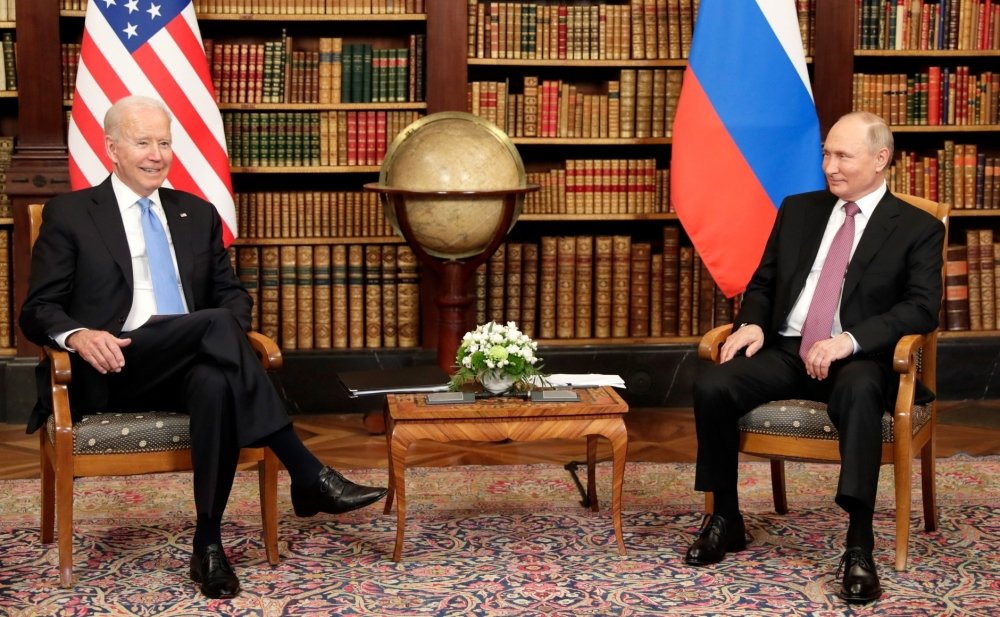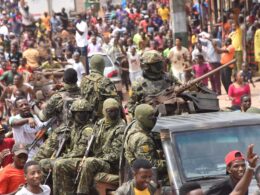Sotsialisticheskaya Alternativa reporters, ISA in Russia
A graphic illustration of the developing conflict was the claim in June by Russia’s Defence Ministry that one of its patrol boats had fired warning shots across the bow of the British Navy Destroyer HMS Defender. Then a Russian aircraft dropped four bombs to head the ship onto a course out of the Black Sea waters around the disputed Crimea. The British Ministry of Defence denied this, saying the Russians had notified them of gun testing in the area. Later, on Russian TV, Putin declared: “Even if we had sunk this ship, it is difficult to imagine that the world is on the edge of a new world war. This is because those who did this [sent the ship into these waters] know that they could not win such a war”.
This single event however is just one indication of the worsening relationship.
The past month has seen a dramatic rise in tensions over the situation in Ukraine. One after another, western leaders, including NATO Secretary-General Jens Stoltenberg and US Secretary of State Antony Blinken have complained that Russia was massing troops around Ukraine. President Biden has been phoning European leaders to coordinate “a comprehensive approach in response to Russia’s build-up on Ukraine’s borders”.
NATO hypocrisy
This, of course, is pure hypocrisy. NATO has been stepping up its military presence with over 7,000 troops supported by tanks and aircraft in countries neighboring Russia. Over the summer 2000 troops and 30 NATO ships took part in exercises in the Black Sea, some of them encroaching into the waters around Crimea, now claimed by Russia.
Russia has not been sitting on its hands. For the second time this year, it has been gathering troops along its border with Ukraine, according to the authorities, to conduct training exercises. Aircraft from both sides are continuously testing each other’s borders.
Zelensky’s failures
When the former TV satirist Volodymyr Zelensky was elected Ukrainian President in 2019, he promised the economy would grow by 40% over the five years of his term of office. Despite this, growth was already slowing by the time Covid hit, and in the second quarter of 2020, it collapsed by over 11%. A limited rebound of +6% in the 2nd quarter of 2021 has already run out of steam. In the words of ‘bne Intellinews” — “the poor recovery of the economy in 3Q21 makes our forecast of GDP growth in 2021 of 4.1% y/y irrelevant.”
This is the background to the events of the last months. Zelensky himself does not have a firm power base within the elite, and for a period found himself and his government pushed here one way, there in another by the different vested interests. Trump’s somewhat unpredictable relationship with Russia allowed pro-Russian oligarchs and interests to gather forces within Ukraine. This led to a cooling of relations with the West, particularly the EU. Pro-Russian oligarchs like Viktor Medvedchuk have increased their domination of the media which, unable to agitate openly for Russian interests, has stepped up anti-western coverage.
With the aftermath of the Belarusian uprising leaving authoritarian President Lukashenko more firmly in the Kremlin’s pocket, Ukraine has lost a potential ally — until recently Lukashenko had withheld his approval for the Russian takeover of Crimea.
Donetsk and Lugansk republics
The situation in the two Ukrainian rebel republics, Donetsk and Lugansk, remains unresolved. On-off skirmishes have continued along the frontline, which is still dominated by WW1 style trenches. The “Normandy format” — negotiations between Ukraine, Russia, Germany and France have stagnated as Macron sought a reset of relations with Russia, while Germany has been more concerned to ensure the flow of gas from Russia.
The two republics have remained under the control of Russian supported right-wing warlords with the economy, in what was once the industrial heartland of the Soviet Union, in a desperate state. The average wage in Donetsk is currently under 200 euros a month. Under the guise of wanting peace in East Ukraine, Russia gives deniable support to the regimes of the two republics and in effect argues for their recognition by Kyiv.
This year, to boost support for Putin’s United Russia party, the Kremlin has allowed residents of the republics to get Russian citizenship. Since the new procedure was introduced in mid-2019, 700,000 applications with access to the higher Russian pensions have been approved. The Kremlin, which already allowed the republics to use the ruble as the main currency has now opened significant economic channels, including allowing the republics to win Russian government contracts.
Biden’s foreign policy
Zelensky’s ratings were already falling when Joe Biden became US President, with his more explicit anti-Russian approach. He has turned to the US for support. He has launched a populist campaign against the ‘oligarchs’ to bar them from controlling the media, influencing political parties or participating in privatisation. Zelensky, whose economic policies are closer to free-market laissez-faire is, in effect, attempting to squeeze more taxes from the oligarchs, while attempting to lessen the influence of those oligarchs such as Rinat Akhmetov, who are seen as closer to Russian business interests.
To curry favour with the State Department, this also means sidelining Ihor Kolomoyskyi, one of Ukraine’s richest men and up till now, an ally of Zelensky as the oligarch is wanted in the US on money laundering and murder charges.
At the same time, Zelensky is coming under growing pressure from the military hawks and far-right nationalists to implement his promise to resolve the East Ukrainian situation. He has said that a key aim of his Presidential term should be to return Crimea to Ukrainian control. This of course has not helped lessen tensions. They were heightened even more when Zelensky announced that a coup against him was being organised at the beginning of December — supposedly by the oligarch Rinat Akhmedov, with the support of Russian forces. To date nothing has yet come of these threats.
This does not mean that the situation is stable. One political analyst says: “the real protest potential is very high. The dissatisfaction that people feel with the direction the country is taking is continuously growing, and the anti-rating of the authorities is very high. There is an ‘ideal storm’ developing in Ukraine. There are simultaneous energy, epidemical and social-economic crises. The external pressure on the country is very high, and the Ukrainian elite is very split.“
Like Russia, Covid is still raging across the country. The third peak which saw the highest number of fatalities — over 800 a day — was seen in October. Unsurprisingly the vaccination rate is under 30%.
Potential energy crisis
The energy crisis is very real, and used as a lever against Ukraine. The country imports a third of its gas, and this created difficulties this year as the price increased. This however is a precursor for when the Nord Stream 2 pipeline comes online, due next year. It has been built to bypass Ukraine, depriving it of $3–4 billion a year in transit charges. The main beneficiary of gas will be Germany, and although the US is opposed to the pipeline, Biden has now implicitly supported it to avoid an open conflict with Germany. Russia is currently waiting the line’s certification by Germany.
To replace the reduction in gas supplies, Ukraine is trying to increase its use of coal. But both private miners such as those owned by Rinat Akhmetov and the state mines have cut production this year. On top of that, Russia has temporarily cut the sale of coal to Ukraine, selling instead to China and other users. Ironically part of the coal which would have been sold will have been dug in the East Ukraine republics.
Russia’s military doctrine
Biden now has persuaded the US’s main allies that Russia is posed to invade Ukraine. In July, the Kremlin adopted a new “National Security Strategy”. According to the Director of the Carnegie Moscow Center the previous strategy written in 2015 dealt with a different era: “Back then, relations with the West had already sharply deteriorated as a result of the Ukraine crisis, but were still considered salvageable; much of the liberal phraseology inherited from the 1990s was still in use; and the world still looked more or less unified. The current version …is a manifesto for a different era: one defined by the increasingly intense confrontation with the United States and its allies; a return to traditional Russian values.”
The Kremlin’s feeling that it is increasingly under siege internationally is not helped by the wave of crises it is experiencing at home. Official health department figures say 280,000 have died from Covid — a fourth peak has only just been passed. There have, however, been more than 820,000 excess (ie more than average) deaths since the start of the pandemic.
As elsewhere, the Russian economy has experienced a bounce back from last year, but the growth rate is already falling again. More significantly real incomes will soon have declined ten years in a row. Inflation has grown significantly — officially reaching 12%. The Central Bank in response has raised rates — this has not yet had any effect on prices but has reduced the amount of credit available for investment by 700 billion rubles — $9 billion — expected to reduce GDP by between 0,5–1% this year.
These issues, together with the continuing corruption seriously undermine support for the regime. It is from a position of weakness that it is stepping up repression. Any opposition organisation, particularly if it has international connections, is under attack. More people have been arrested for taking part in protests in 2021 than during the whole previous 17 years. In the coming week, according to the monitoring site ‘ovdinfo’ there are 18 political trials scheduled.
Kremlin’s red lines
The strategy that the Kremlin has approved talks of strengthening relations with the countries of the CIS — (the former Soviet republics without the Baltic states and Georgia), with China, India, SE Asia, Africa and Latin America. It makes a particular point of strengthening the “fraternal ties” between the Ukrainian, Belarussian and Russian peoples. In doing this it uses the word “Russky” meaning the Slavic ethnic Russians, rather than “Rossisky” which includes all the other nationalities living in the Russian Federation.
What this means in reality is that the Kremlin does not want to restrict Russian influence to Belarus and the disputed Ukrainian regions, but wants to maintain the two rebel republics as leverage against the Kyiv government. Moreover, it understands very well that if it was to move against Ukraine as a whole, it would probably find itself in direct conflict with NATO troops.
Nevertheless, it has defined what it sees as red lines that should not be crossed: Ukraine should not join NATO, nor should NATO weaponry be deployed in Ukraine. Turkish drones were used to high effect by Azerbaijan in the recent Nagorno-Karabakh conflict, and in October a Turkish built drone was used by Ukrainian forces to attack an artillery base in the Donetsk republic.
Threat of sanctions
The recent build-up of Russian forces on its border with Ukraine is probably with the intent of warning Ukraine and its NATO supporters from going too far. If Ukraine was to provoke a conflict, the result would probably see the two republics taken over by Russia, for which dramatic sanctions would be applied. The Latvian foreign minister, for example, says that sanctions should include the deployment of NATO troops and missiles to the Baltic states, the cutting off of Russian banks from the SWIFT international payment system and an end to NordStream 2.
The Kremlin is, of course, not concerned just about Ukraine. After last year’s uprising in Belarus, President Lukashenko has been forced back into the Kremlin’s pocket. In the Caucasian republics of Azerbaijan, Armenia and Georgia, Russia has to compete with Turkish, Chinese and Western interests. Moldova’s President Maia Sandu is striving to take the country out of the Russian sphere of influence by joining the EU, while threats by the Republika Srpska government in Bosnia to set up its own army raises the perspective of a new military conflict there. In Central Asia following the US withdrawal from Afghanistan, Russia has increased its military presence on the Tajik, Uzbek borders supposedly to stop Taliban intervention into the region.
Russia and China
Further afield, Russia has openly intervened in Syria and Libya — of course there running up against the interests of other imperialist powers. It uses ‘deniable’ mercenary forces to intervene in countries such as the Central African Republic and Mali.
Naturally as the walls are going up between Russia and the West, the former is turning more to the East for friendship. In those parts of the world where China and Russia are competing, they are developing a certain division of labour. China uses its economic levers and Russia its military in Africa, Afghanistan and elsewhere. At the same time military cooperation between the two is increasing. Joint Sino-Russian bomber flights last month crossed into Japanese and South Korean air defence zones, provoking protests from the Japanese foreign minister. Economically, China is turning to Russia to replace energy supplies lost from Western suppliers. It is financing the construction of the Yamal LNG plant in the Arctic circle, and the ‘Power of Siberia 2’ gas pipeline. This project, costing $55 billion is the largest in modern Russia’s history, and will be capable of switching gas flows from the EU to China if the need arises.
What we are now seeing is the intensification of conflicts and polarisations between the different imperialist powers. The whole situation makes the struggle for an internationalist, socialist solution even more urgent.












